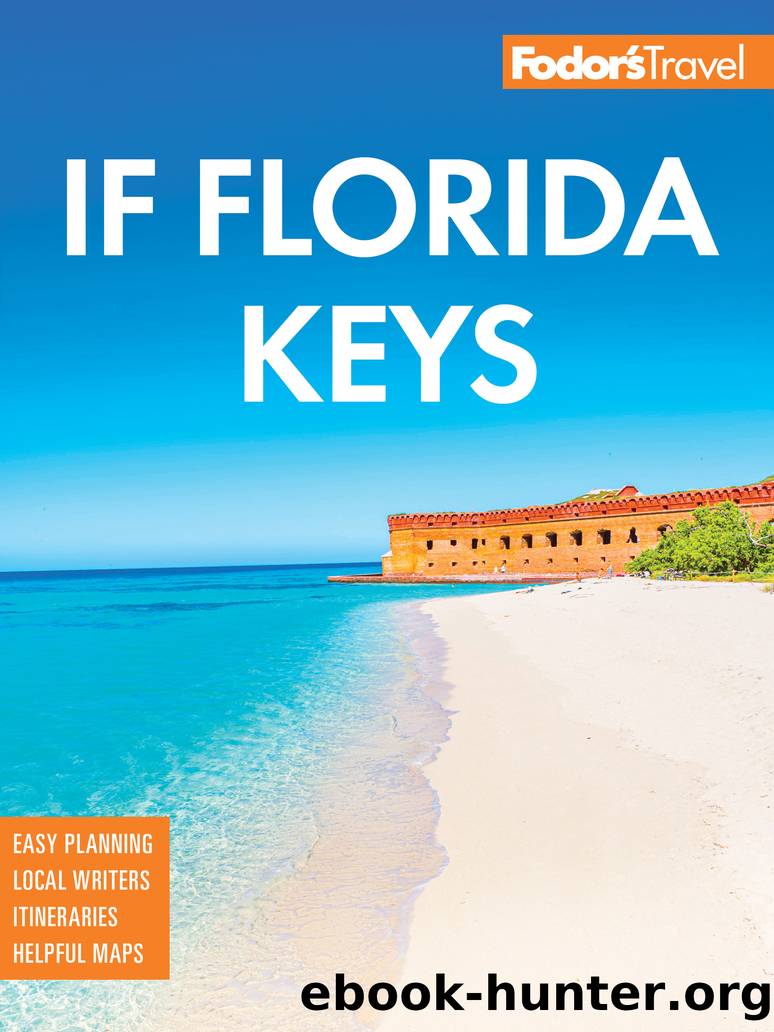Fodor's InFocus Florida Keys by Fodor's Travel Guides

Author:Fodor's Travel Guides [Fodor’s Travel Guides]
Language: eng
Format: epub
Publisher: Fodor's Travel
Published: 2023-03-28T00:00:00+00:00
Big Pine Key
Between MM 32â30.
Welcome to the Keysâ most natural holdout, where wildlife refuges protect rare and endangered animals. Here you swap the commercialism of the Upper Keys for an authentic backcountry atmosphere. How could things get more casual than Key Largo, you might wonder? Find out by exiting U.S. 1 to explore the habitat of the charmingly diminutive Key deer or cast a line from No Name Key Bridge.
Tours explore the expansive waters of the National Key Deer Refuge and Great White Heron National Wildlife Refuge, one of the first such refuges in the country. Along with Key West National Wildlife Refuge, it encompasses more than 200,000 acres of water and more than 8,000 acres of land on 49 small islands. Besides its namesake bird, Great White Heron National Wildlife Refuge provides habitat for uncounted species of birds and three species of sea turtles. It is the only U.S. breeding site for the endangered hawksbill turtle.
GETTING HERE AND AROUND
Most people rent a car to get to Big Pine Key so they can also explore Key West and other parts of the chain.
VISITOR INFORMATION
CONTACT Lower Keys Chamber of Commerce. E31020 Overseas Hwy., Big Pine Key P305/872â2411, 800/872â3722 wwww.lowerkeyschamber.com.
s Sights
National Key Deer Refuge
WILDLIFE REFUGE | FAMILY | This 84,824-acre refuge was established in 1957 to protect the dwindling population of the Key deer, one of more than 22 animals and plants federally classified as endangered or threatened. The Key deer, which stands about 30 inches at the shoulders and is a subspecies of the Virginia white-tailed deer, once roamed throughout the Lower and Middle Keys, but hunting, destruction of their habitat, and a growing human population caused their numbers to decline to 27 by the middle of the last century. The deer have made a comeback, increasing their numbers to approximately 750. The best place to see them in the refuge is at the end of Key Deer Boulevard and on No Name Key, a sparsely populated island just east of Big Pine Key. Mornings and evenings are the best time to spot them. Deer may turn up along the road at any time of day, so drive slowly. They wander into nearby yards to nibble tender grass and bougainvillea blossoms, but locals do not appreciate tourists driving into their neighborhoods after them. Feeding them is against the law and puts them in danger.
A quarry left over from railroad days, Blue Hole is the largest body of fresh water in the Keys. From the observation platform and nearby walking trail, you might see the resident alligators, turtles, and other wildlife. There are two well-marked trails, recently revamped: the Jack Watson Nature Trail (0.6 miles), named after an environmentalist and the refugeâs first warden, and the Fred C. Mannillo Wildlife Trail (0.2 miles), one of the most wheelchair-accessible places to see an unspoiled pine-rockland forest and wetlands. The visitor center has exhibits on Keys biology and ecology. The refuge also provides information on Key West National Wildlife Refuge and Great White Heron National Wildlife Refuge.
Download
This site does not store any files on its server. We only index and link to content provided by other sites. Please contact the content providers to delete copyright contents if any and email us, we'll remove relevant links or contents immediately.
Machine Learning at Scale with H2O by Gregory Keys | David Whiting(3987)
Never by Ken Follett(3717)
The Ultimate Backcountry Survival Manual by Aram Von Benedikt; Editors of Outdoor Life;(3192)
Fairy Tale by Stephen King(3164)
The Man Who Died Twice by Richard Osman(2963)
Will by Will Smith(2745)
Friends, Lovers, and the Big Terrible Thing by Matthew Perry(2086)
Cloud Cuckoo Land by Anthony Doerr(2004)
A Short History of War by Jeremy Black(1732)
Go Tell the Bees That I Am Gone by Diana Gabaldon(1655)
515945210 by Unknown(1572)
A Game of Thrones (The Illustrated Edition) by George R. R. Martin(1516)
443319537 by Unknown(1441)
The 1619 Project by Unknown(1356)
Works by Richard Wright(1242)
Meditations (Modern Library) by Marcus Aurelius(1225)
All About Love: New Visions by bell hooks(1179)
Going There by Katie Couric(1136)
book title by 2023(1058)
